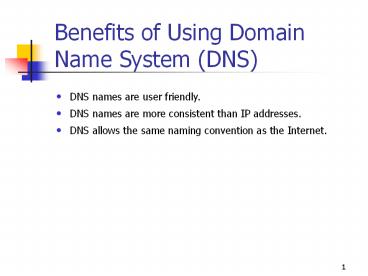Benefits of Using Domain Name System (DNS) - PowerPoint PPT Presentation
Title:
Benefits of Using Domain Name System (DNS)
Description:
Benefits of Using Domain Name System (DNS) DNS names are user friendly. ... A name server in each domain contains the master database file. ... – PowerPoint PPT presentation
Number of Views:717
Avg rating:3.0/5.0
Title: Benefits of Using Domain Name System (DNS)
1
Benefits of Using Domain Name System (DNS)
- DNS names are user friendly.
- DNS names are more consistent than IP addresses.
- DNS allows the same naming convention as the
Internet.
2
Domain Name Space
3
Examples of Second-Level Domains
- Ed.gov
- Microsoft.com
- Stanford.edu
- W3.org
4
Host Names
- Refer to specific computers on the Internet or an
intranet - The leftmost portion of a fully qualified domain
name (FQDN), such as Computer1.sales.microsoft.com
- Does not have to match the computer name
5
Domain Naming Guidelines
- Limit the number of domain levels.
- Use unique names.
- Use simple names.
- Avoid lengthy domain names.
6
Domain Naming Guidelines (continued)
- Use standard DNS characters and Unicode
characters - Microsoft Windows 2000 supports AZ, az, 09,
hyphen (-) - Supports Unicode character set
7
Zones
8
Name Servers
- Store the zone database file
- Store the database file(s) for one or multiple
zones - Have authority for the domain name space that the
zone encompasses - Are required in every zone
9
Primary Zone Database File
- A name server in each domain contains the master
database file. - Changes to a zone are performed on it.
- Multiple name servers act as a backup.
10
Benefits of Multiple Name Servers
- Provide zone transfers
- Provide redundancy
- Improve access speed
- Reduce the load
11
Name Resolution
- Resolving names to IP addresses
- DNS resolves www.microsoft.com to an IP address
12
Forward Lookup Query
13
Name Server Caching
14
Reverse Lookup Query
- Maps an IP address to a name.
- Used by troubleshooting tools such as the
nslookup utility. - Some applications implement security based on the
ability to connect to names.
15
The in-addr.arpa Domain
16
Introduction to DNS Clients
- DNS is a distributed database used in TCP/IP
networks. - TCP/IP must be installed to use DNS.
17
Internet Protocol (TCP/IP) Properties Dialog Box

